MEMORIES—OF LIGHTNING BUGS, JUNE BUGS, AND JUBILATION
June invariably takes me back to the carefree days of a Smoky Mountain boyhood. School was finally out, and even in those years where we had to suffer attendance on a few Saturdays and continue classes right through May because of making up missed classes for what were called “snow days” (school days when snowy roads made travel too dangerous for buses), June meant freedom. That took many forms, and some of them were both simple and supremely satisfying.
You could chase lightning bugs in the gloaming and place them in a Mason jar while telling yourself you were the proud possessor of an ersatz flashlight. I relished the activity but had to give it up thanks to what may be about as strange an allergy as one’s imagination could conjure up. Smelling lightning bugs, and they emit a distinct aroma, launches me into almost non-stop fits of sneezing. I soon learned to avoid them at least to the degree of not catching and handling them as they sent out their mating signals (that’s what the “lights” are).
Another bug of considerable interest was the June bug. They also stink when caught, but I don’t have any allergic reaction to them. However, I did delight in capturing four or five of them when the sun had not yet driven away the dew. June bugs are big insects (no wonder the description I’ve heard countless times over the years, “he jumped on that project like a chicken on a June Bug,” because a June big made a nice snack for free-range chickens) and seemingly can’t fly until their wings dry out. Much the same is true for grasshoppers and Japanese beetles. I mention these because ‘hoppers were fine fish bait while highly destructive Japanese beetles could be shaken from vegetation into a buck of soapy water, thereby ending their constant leaf-munch marauding, pausing only to procreate, in the dews of early morning or the damp of ending day.
As for June bugs, they were a simple source of entertainment. With a few lengths of sewing thread purloined from the vast selection of spools Mom had for her never-ending efforts as a seamstress, it was possible to engineer insect helicopters. One simply made a loop with a slip knot, eased it around a June bug’s leg, tightened the loop, and then waited until it showed signs of wanting to fly away from the jar where it had been warming up in the sun. For a short time you had a tethered, live, miniature equivalent of a kit, although the June bugs soon recognized the futility of flight and ceased operations. That was why you had a fleet of June bug helicopters—when one gave up the ghost it was time to turn to the next one.
Those were but two of an incredible array of activities which provided cost-free entertainment, all of it sheer jubilation, for me as a boy. The others seem to have been almost without number, but they did share two common characteristics. They cost little or nothing and with the single exception of reading (and I’ve always been a keen reader) they took place outdoors. Summertime reading was reserved for the occasional all-day rain. Here’s a list of a dozen pursuits which kept me preoccupied for countless hours as a kid, although I know that I’ll no sooner move on to another section of this newsletter than other activities will come to mind. I suspect every one of you can make your own additions, and if so, you are doing one of the things I aspire for with these ramblings—offering an incentive to wander back to simpler days and simpler ways.
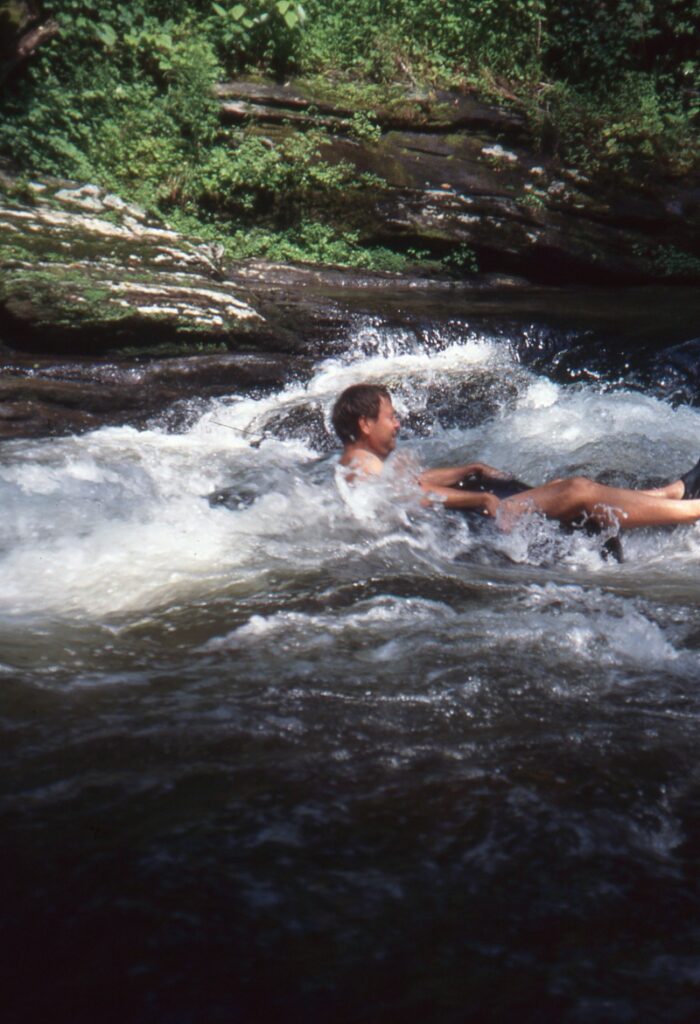
*Float tubing. Our tubes weren’t store-bought but rather patched, decrepit automobile or truck inner tubes which had seen their better days. In these conveyances I spent many an idle hour floating down nearby Deep Creek. Then you seldom saw anyone other than your companion floaters. Today the stream is terribly crowded.
*Once the inner tubes used for floating had been patched beyond recovery, they were recycled yet again—this time for raw material to craft slingshots. Shooting those slingshots, searching creek and river banks for suitable ammo for them, and feeling as if you were a “licensed weapon carrier” when you had a catapult in your back pocket filled a lad with delight.
*The same sources which provided slingshot ammunition offered other pleasant activities. It was great fun to look for good skipping rocks and then see how many skips could be gotten from a thrown stone before the combination of dwindling momentum and weight took it beneath the river’s surface.
*Bike riding. The bike I grew up riding all had only one speed; featured pedal brakes; had chains which could absolutely gobble up pants legs; and came outfitted with a capacious basket perfectly suited for carrying my lunch, a fishing creel, fishing vest, change of clothes if some swimming was on the agenda; and cost the whopping sum of $10 used. I most assuredly got my money’s worth many times over, and the bike was obviously made well. I don’t think I ever had any problems with it other than a wreck which broke the frame (Daddy managed to repair it and I got additional years of service). It served me from when I was 8 or 9 right through high school (it was a different world, and it was a rare boy, even those who were 17 or 18, who had a vehicle). It got me where I wanted to go, beat shank’s mare hollow, and cost nothing other than the expenditure of some of what was then an abundance of energy.
*Fort building. Up until high school years I believe I built at least one “fort” every summer. It was a time of Western movies, great interest in pioneer life, and a kind of patriotic mindset which had every red-blooded American boy thinking playing soldier, scout, pioneer, or the like.
*Minnow seining. Catching minnows for fun, fish bait, or to sell, using a tow sack cut open on one side and bottom made a fine seine, and the whole process was sheer joy. Local branches were full of minnows, and from time to time a water snake would end up in the seine, as would spring lizards and crayfish.
*Catching night crawlers after a warm rain in late afternoon or an all day rain such as we have just experienced. Night crawlers brought welcome “cash money,” fetching a dime a dozen and, just before I finished high school, the price scale moved up to a penny apiece. A good night’s outing could find one catching 400 to 500 of these giants of the world of worms, and in the 1950s that was really serious money for a normally impecunious boy.
*Going barefooted. By the time June rolled around and school let out, my feet would be toughened up to the point that hot cement or asphalt posed no challenge, and warding off briars (although not honey locust thorns) was kid’s stuff. One regular test for the depth and merit of calloused bare feet was to use your foot to mash someone’s cigarette butt. If you could do it painlessly you knew summer had truly arrived.
*Catfishing. For me it came in many forms, and June always marked the start of serious business with Mr. Whiskers. There were trot lines, throw lines, traps, limb lines, and jug lines, not to mention fishing with a pole (I don’t say rod and reel because my catfishing gear was simpler—just a cane pole outfitted with black nylon line).
*Speaking of cane poles, no start to summer was complete without a session of cane pole preparation. That included cutting the canes, removing all foliage from them, hanging them from barn rafters to straighten and cure, and finally rigging them with a length of line, a sinker made from the lead covering to roofing nails, and a homemade bobber made from real cork.
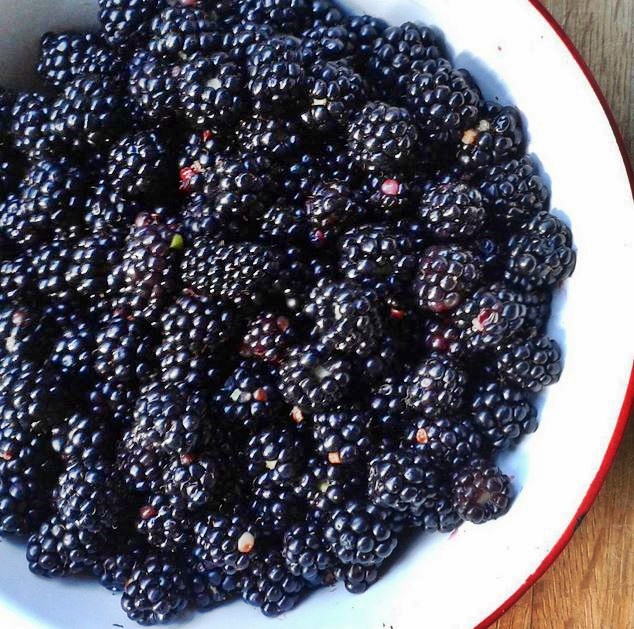
*As for berries, June was the month for enjoying not one but three types of berries which were plentiful and incredibly delicious—black raspberries, dewberries, and blackberries. Old Will Shakespeare once wished (through the voice of Henry IV) that “reasons were as plentiful as blackberries.” They aren’t, but blackberries are plentiful in many areas and a source of pure delight for anyone with the gumption to pick them. I picked a mess last week and intend to do the same again tomorrow morning. Like night crawlers, they were a source of income for me as a lad, bringing what now seems the incredibly paltry price of two bits a gallon. Yet I picked countless gallons and gladly sold them at this price.
*Of all the memories filling my mind when it comes to June, however, trout fishing has to take pride of place. By June the spate of fishermen who flocked to streams like a fine caddis hatch in late April and May had abated, and no longer was it necessary, even in readily accessible spots, to carry your own rock if you wanted a place to stand. Indeed, week days would usually mean total solitude when astream. Since I found at least an hour or two to fish virtually every late spring and summer day of my adolescence, that meant lots of wonderful hours of casting without seeing another angler. Maybe that’s where the misanthropic side of my character developed, because I’m still someone who can be quite comfortable alone for long stretches of time.
BOOK ALERT
When the withering heat of summer drives you indoors, that’s a prime time for reading. At least that has long been the case for me. Along with writing sessions, and I try to spend a few hours committing thoughts to paper (or more accurately I guess, putting them into the bowels of a computer whose function I can’t even begin to understand), I read some every day. Thanks to a fortuitous recent development, here’s a chance for you to pick up some summer reading at a bargain price.
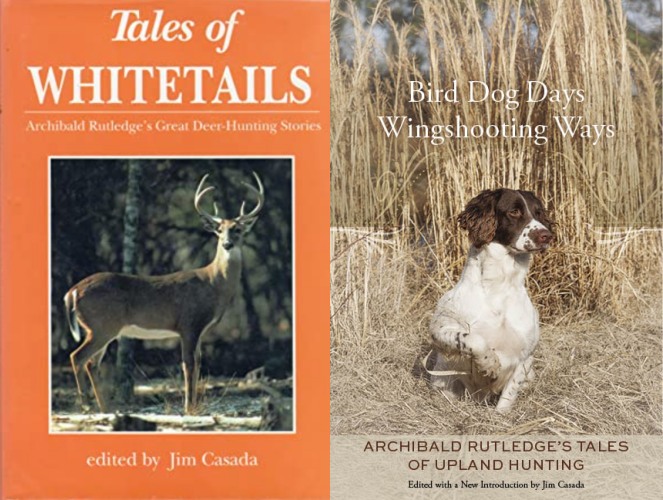
Go to any of the numerous lists of used books on my website (www.jimcasadaoutdoors.com) or to any of the books I have personally written and edited, and peruse them for items you would like to add to your library. If you order $100 or more (not counting shipping costs) I’ll add a free signed and inscribed copy of your choice from either Tales of Whitetails: Archibald Rutledge’s Great Deer Hunting Stories or Bird Dog Days, Wingshooting Ways: Archibald Rutledge’s Tales of Upland Hunting to the order. For orders of $200 or more I’ll send both volumes. Alternatively, if you just want one or both of these books or would perhaps like to obtain some gifts at a bargain price, they are $15 each postage paid. These are attractive, hardbound books in dust jackets, and anyone conversant with outdoor literature likely realizes that Rutledge was one of the finest, most prolific sporting scribes America has ever produced. I hope my accompanying words and editorial effort (I edited and compiled both anthologies) do him at least partial justice.
LAUGHTER: TRULY THE BEST MEDICINE
The ability to laugh, and especially to laugh at ourselves, is a priceless quality adding zest to life as it smoothes our daily path. Often laughter comes from pranks such as country kids managing to convince visiting city cousins that a persimmon showing its fall orange color is a taste-tempting treat of great delight. On other occasions it takes the form of the misfortune of some fellow being who maybe richly deserved their fate or, once everything turned out all right, could join in the hilarity.
I’m not exactly sure where an incident from my youth falls in this regard, but I never think of it without chuckling a little bit and cringing a lot. The brother of a youthful friend of mine who was later my college roommate for a year was one of those exuberant, innocent, sometimes obnoxious, and always distinctly different souls. He wasn’t exactly a misfit but rather someone who was always seeking to fit in where he probably didn’t belong. Such was the case when it came to deciding to become an overnight woodsman, accomplished Boy Scout, and natural history expert.
He took to wandering the woods, playing in creeks and branches, and generally doing things completely alien to what heretofore had been pretty much of a couch potato existence. One fateful day that new persona included an ill-considered decision to follow up a woodland bowel movement with the use of some readily available, biodegradable wiping material. Sadly, he found some shiny green, three-leaved vegetation adorning vines running along the ground and up a tree in immediate proximity to where he had done his business and used a number of the leaves for the clean-up process.
As I’m sure you’ve already guessed, the leaves were from poison ivy, and in fairly short order his nether parts were in a singularly sad state. Lyrics from an old song suggesting “you’re gonna need an ocean of Calamine lotion” did not even begin to address the problem. It took a trip to the doctor, some rigorous remedial treatment, and several days of pure misery for things to get back to normal for this poor soul. Of course once word got out everyone else, including me, thought it was hilarious. One thing for certain—henceforth he knew the difference between poison ivy and Virginia creeper.
JIM’S DOIN’S
Probably the biggest news on the home front focuses on completion of the first draft and first round of proofreading on another book. The work doesn’t have a final title at the moment, although I’ve been working with “Nimrods in Africa.” This is the first of a projected two- or possibly three-volume treatment of the subject, and this opening offering involves individuals who were the pioneers in African hunting endeavor. I’ve written fairly detailed profiles of 17 great hunters covering the Victorian and Edwardian eras. I begin with the likes of William Cornwallis Harris and Sir Samuel White Baker and conclude with chapters on turn-of-the-century sportsmen such as Theodore Roosevelt and Frederick Vaughan Kirby. Accompanying each biographical entry is a selection from the individual’s writing. Other features will include an image of each individual and lithographs from great illustrators who made so many of the books of these writers a visual feast. The book will be published by Sporting Classics and our goal is to have it ready for inclusion in the magazine’s Fall catalog and available in plenty of time for the Christmas market. If you would like to be notified when it becomes available, just send me an e-mail and I’ll make sure you are added to my “notify when available” list.

Another piece of big news, at least for me, was notification that my book, A Smoky Mountain Boyhood: Memories, Musings, and More, won a bronze medal in the Southeast Non-Fiction category in the annual Independent Publishers competition (the IPPY competition). The overall contest is the biggest one of its kind—this year there were more than 4500 total entries for the various categories—and needless to say I’m delighted to have a book among those to be recognized.
I just enjoyed a wonderful trip down a lane to the past which covers a period dating back some four decades. As I’ve mentioned on a couple of occasions, I began the program and for a dozen years served as head men’s soccer coach at Winthrop University. Periodically over the years a goodly number of the players from the “earlies” (the program began in 1975 and I coached through the 1986 season) have gotten together. Initially it was for alumni matches and then, as they got older and that kind of strenuous activity became more questionable for most of them, to recognize a fellow player being inducted into the Winthrop Athletics Hall of Fame, soccer homecoming, or some similar occasion.
What has always amazed me is the sense of togetherness, love for one another, and enduring friendships which exist among these former student-athletes. As I told 40 to 50 of them who gathered recently, along with that many more spouses and longtime friends, I have taken great pride and considerable joy in seeing them become successful parents, meaningful members of the community, individuals who give back to the world, and generally fine human beings. I don’t know that I can claim much credit for any of their myriad achievements, but I can say unequivocally that I look back on their playing days and where they are now with genuine fondness.
My contributions to magazines and Internet publications continue at pretty much the normal rate, and here’s a list of what has appeared since last month’s newsletter. There are a trio of pieces in “Sporting Classics Daily”–“The Sportsman’s Code of Hunting Ethics,” May 17, 2021; “The Political Responsibilities of Sportsmen,” June 1, 2021; and “In Praise of Pocket Knives,” June 22, 2021. The latter piece is a revised version of an award-winning article which previously appeared in South Carolina Wildlife. For Sporting Classics magazine there’s my regular book column, this one “The Genius of Corey Ford,” in the July/August issue. I continue my food coverage for Smoky Mountain Living in the June/July issue (a couple of the recipes covered there appear below, and if you want a bi-monthly taste of the mountains, the magazine offers grand armchair adventure). Finally, there’s “The Simple Pleasures of Picking,” in Columbia Metropolitan magazine for June. I might note that I’ve been out picking blackberries once and intend to do it once more before they are gone for the year.
RECIPES
TROUT ON THE TABLE:
A MOUNTAIN TASTE TREADITION
One of the more frequently used quotations from 19th century wilderness wanderer, writer, and philosopher Henry David Thoreau suggests that “some men fish all their lives without knowing it is not really the fish they are after.” Perhaps that is true for “some men,” but rest assured that traditional mountain folks, closely attuned to and wonderfully adept at living off the land, would have dismissed such thinking out of hand. My mother addressed the whole matter quite nicely with her pithy thoughts on the popular practice of catch-and-release among today’s trout fishermen. In her view that approach was fine, but with a strong caveat—you released the trout to a sizzling pan of hot grease, not the stream from which they came.
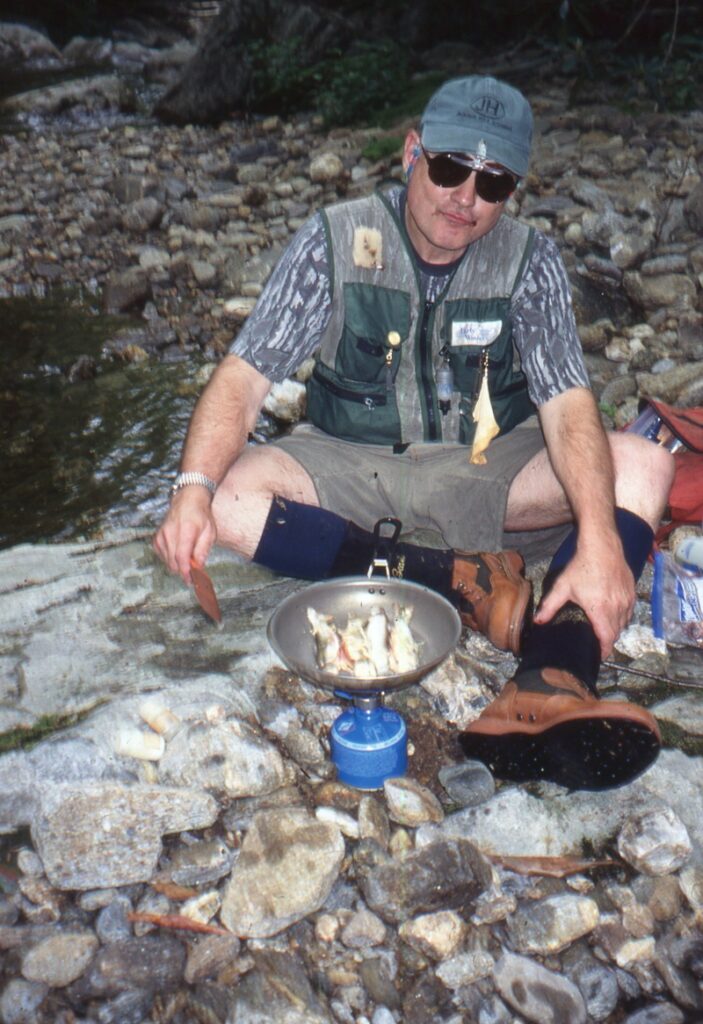
The very idea of going fishing, enjoying success, and not bringing home a mess was in her view absolutely ludicrous. Over the course of my life I’ve been responsible for many a trout being all dressed up in a cornmeal dinner jacket, fried to a golden turn, and gracing plates in a backcountry camping site. Some of the finest meals I’ve ever enjoyed have been in such settings, often with the trout having been swimming in cold, clear waters of a nearby mountain stream just a half hour earlier. A speckled trout which is barely keeping size, fried so crisp you can eat bones and all, comes mighty close to culinary heaven. Change the setting from the back woods to the family table and the accompanying fare might have been more diverse although the fish weren’t fresh from the creek. In either case, as my Grandpa Joe might have put it when speaking of such superb fare, the only thing better than a properly prepared trout is several of them. Here are some ways to enjoy this traditional mountain delicacy.
PAN-FRIED TROUT
2 to 3 small trout (6 to 8 inches length is ideal—they are tastier than larger ones) per person, dressed
Stone-ground cornmeal
Salt and pepper
Bacon grease or lard
Clean the fish and leave damp so they will hold plenty of corn meal. Put your cornmeal in a Zip-lok bag, add the trout, along with salt and pepper, and shake thoroughly. Make sure the inside body cavity gets a coating of corn meal. Cook strips of bacon or streaked meat and save grease, setting the meat aside to mix with a green salad or to crumble into fried potatoes. Place the trout in a large frying pan (a cast-iron spider works wonders but modern non-stick kitchen ware is quite suitable) holding piping hot grease. Cook, turning only once, until golden brown. You can help the process along by using a spatula or tilting the pan a bit to splash grease into the open body cavities. Place cooked fish atop paper towels, pat gently to remove any excess grease, and dig in. If it is springtime, serve with a backwoods “kilt” salad (branch lettuce, ramps, and bacon bits with leftover hot cooking grease poured over it for a dressing), fried potatoes and onions with bacon bits added, and something for the sweet tooth to finish.
TROUT OMELET
This is a fine breakfast dish but can be served at any meal. If used for dinner or supper a green salad or fruit mix is a nice accompaniment, while at breakfast a cathead biscuit partners up in mighty fine fashion.
2 cups cooked and flaked trout (I like to poach them in butter)
1 cup cottage cheese
6 large eggs
½ cup minced onion
½ cup chopped mushrooms
½ cup fresh spinach, chopped
Sour cream
Butter
Mix eggs and vegetables in a small bowl then combine with cottage cheese and beat until fluffy. Pour into a buttered frying pan and cook slowly on low heat until the eggs start to set. At this point pour previously cooked trout on top, add a dollop of sour cream, and then carefully fold to finish cooking the omelet. Season with salt and pepper and top with paprika or chopped parsley if desired. Serves three or four.
TROUT BAKED IN FOIL
While I’d argue, perhaps with some vehemence, that nothing quite matches fresh-caught trout fried over an open fire in a backcountry campsite, perhaps with a side dish of ramps and branch lettuce or fried potatoes and onions, you can skip the grease and use foil for the cooking process. This works on an open fire if you know what you are doing with coals, on a backyard grill, or in the kitchen oven. Place each serving of trout in its own container of tinfoil, folding carefully so everything stays inside. Line the body cavity with a couple of pats of butter, insert thin slices of lemon, or dust with whatever combination of herbs appeals to you (dried parsley, perhaps with just a touch of red pepper flakes, is particularly good). Cook until the flesh easily flakes from the bones, and be aware of the fact this won’t take long.
Summertime brings fish to the table but it also is a time to begin cleaning out last fall’s packages of venison as you look forward to another hunting season and hopefully plenty more meat for the freezer. Here are a couple of thoughts on how to use that frozen venison. Also, I would point out that one of the two best-selling books I’ve ever been involved with is The Complete Venison Cookbook. It is available through my website and some 200 recipes should fill a niche for about any menu imaginable.
CROCKPOT VENISON CUBED STEAK
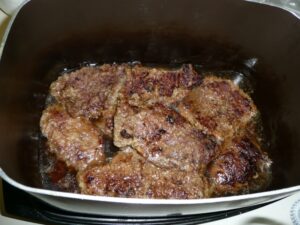
I love crockpot cookery because it works wonders and does so with minimal time requirements. One of my favorite recipes is to put a package or two of venison cubed steak in the cooker (I’ll first flour and brown the cutlets if I have time, but I don’t always do that) with a large can of cream of mushroom soup mixed according to instructions. That is usually adding an equal amount of water to the soup mix. Turn the crockpot setting to medium and let it go for five or six hours. Sometimes, though not always, I’ll add a couple of handfuls of rice at a point where there’s the needed time for the rice to cook before I plan to serve the cubed steak. You can also add frozen green peas, sliced carrots, and potatoes if you want something more closely approaching a rich stew. The cooking time for carrots and potatoes is appreciably longer than that for peas.
The end result is always scrumptious, and for me there’s enough salt in the soup to flavor the dish. I do add a goodly amount of black pepper. With some fresh fruit or a green salad, you have a full, hearty meal.
CHEESEBURGER PIE
If you are like me, chances are you have more ground venison left in the freezer than anything else. Here’s a scrumptious way to use it that offers a bit of variety from the traditional burger route.
1 pound ground venison
½ cup evaporated milk
½ cup ketchup
1/3 cup fine bread crumbs
¼ cup chopped onion
½ teaspoon dried oregano
Salt and black pepper to taste
1 cup sharp cheddar cheese, shredded
1 teaspoon Worcestershire sauce
1 8-inch prepared pie shell
Combine venison, milk, bread crumbs, onion, and oregano. Season to taste with salt and pepper. Prepare pastry to line one 8-inch pie plate with prepared pastry shell (or make your own). Fill with venison mixture. Bake at 350 degrees for 35 to 40 minutes. Toss cheese with Worcestershire sauce and sprinkle atop pie. Bake 10 minutes more and let stand 10 minutes before serving.